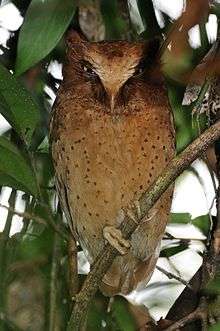Serendib scops owl
The Serendib scops owl (Otus thilohoffmanni) is the most recently discovered bird of Sri Lanka. It was originally located by its unfamiliar poo-ooo call in the Kitulgala rainforest by prominent Sri Lankan ornithologist Deepal Warakagoda. Six years later, it was finally seen by him on 23 January 2001 in Sinharaja, and formally described as a species new to science in 2004.[2] Apart from Sinharaja and Kitulgala, it has also been found at Runakanda Reserve in Morapitiya and Eratna Gilimale. Known as පඩුවන් බස්සා in Sinhala.
| Serendib scops owl | |
|---|---|
 | |
| Serendib scops owl | |
| Scientific classification | |
| Kingdom: | Animalia |
| Phylum: | Chordata |
| Class: | Aves |
| Order: | Strigiformes |
| Family: | Strigidae |
| Genus: | Otus |
| Species: | O. thilohoffmanni |
| Binomial name | |
| Otus thilohoffmanni Warakagoda & Rasmussen, 2004 | |
It is the first new bird to be discovered in Sri Lanka since 1868, when the Sri Lanka whistling thrush—then Ceylon whistling thrush—(Myophonus blighi) was discovered. It is also the 24th (according to some authorities the 27th) endemic bird species for Sri Lanka.
The habitat of the Serendib scops owl is in the southern rain forests of Sri Lanka. There is an altitudinal range from 30 to 50 metres. This owl has no competition from other nocturnal birds, the territories are completely different. This species has a very small population, at the end of January 2006 only 80 of them were known to exist.[3] The places that it is expected to be found are in five protected areas, like the Forest Reserve or the Proposed Reserve by Sri Lanka. They seem to be declining because of the loss of habitat and the degradation. The first two hours of darkness is when the owl hunts for its food.
This rare species inhabits the rainforests in the southwestern part of Sri Lanka. Like most owls, it is strictly nocturnal and hunts insects (e.g. beetles and moths) close to the ground. It begins calling at dusk, its frequency rising again some two hours before dawn.
Unlike the other two species of scops owl in Sri Lanka, Indian scops owl (Otus bakkamoena) and oriental scops owl (Otus sunia), it does not have ear tufts and its facial disc is only weakly defined. The general colour of this 16.5 cm long, short-tailed owl is reddish brown with paler underparts, spotted all over with fine black markings. The irides are tawny yellow (more orangish in male) and the feet are a pale fleshy colour. Tarsi are feathered for less than half their length. The claws and bill are a pale ivory colour.[4]
Taxonomic status
In 2006 and 2007, two papers were published by Sri Lankan ornithologists in the publication Loris questioning whether the Serendib scops owl was a distinct species from other scops owl species found in India, and if so, whether it was actually a new discovery or a rediscovery.[5][6]
The species has been subsequently recognized as a valid and distinct species by two of the authors who had earlier speculated on its “taxonomic uncertainty” in the papers mentioned above, in their following works.
- Birds of Sri Lanka: A Tally List (2009) by C. D. Kaluthota and S. W. Kotagama.
- An Illustrated Guide to the Birds of Sri Lanka (2010) by S. W. Kotagama and G. Ratnavira.
The question of ‘ear-tufts’ in this species, which has been misunderstood and led to questioning of its “taxonomic uncertainty” in the papers above, had already been dealt at length in two articles at:
In culture
This bird appears in 20 Sri Lankan rupee bank note (2010 series).[7]
References
- BirdLife International (2012). "Otus thilohoffmanni". IUCN Red List of Threatened Species. 2012. Retrieved 26 November 2013.CS1 maint: ref=harv (link)
- Warakagoda, Deepal H. & Rasmussen, Pamela C. (2004): A new species of scops owl from Sri Lanka. Bulletin of the British Ornithologists' Club 124(2): 85–105. PDF fulltext Archived 2014-02-07 at the Wayback Machine
- "Arkive conservation". Archived from the original on 2010-11-19. Retrieved 2010-11-30.
- "Arkive description". Archived from the original on 2010-11-19. Retrieved 2010-11-30.
- Kotagama, S.W., De Silva, R.I. and Kaluthota, CD. 2006. "Taxonomic uncertainty of the new species of Scops-owl from Sri Lanka (Part 1)". Loris 24 (3 & 4): 21–23.
- Kotagama, S.W., De Silva R.I. and Kaluthota, C.D. 2007. "Taxonomic uncertainty of the new Scops Owl from Sri Lanka - Part 2". Loris 24 (5 & 6): 48
- "Archived copy". Archived from the original on 2017-08-03. Retrieved 2017-07-23.CS1 maint: archived copy as title (link)
Bibliography
Rasmussen, P. & Anderton, J. (2005). Birds of South Asia. The Ripley Guide Lynx Edicions, Barcelona and Washington D.C.
